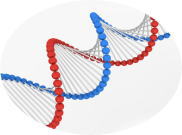Learning page for beginners No.2 - Genetic Analysis
 |
Hello again from the Project Office in the National Institute of Nutrition (NIN), Hanoi. Today, I'd like to ask Mr. Ueda Shuhei, an invited researcher from University of the Ryukyus , about a genetic analysis on antimicrobial resistant bacteria. |

Mr. Ueda (right) with NIN researchers
Hello Mr. Ueda, what are you doing now ?
I am analyzing genotype and phylogenetic type of ESBL-producing E.coli.
![]() In simple please?
In simple please?
ESBL-producing E. coli make the enzymes inactive the power of particular antibiotics.
I'm checking the genes of these E.coli.
OK, ESBL-producing E. coli are a group of drug resistant bacteria.
They use enzymes to break antibiotics, so they are resistant to antibiotics.
Why are you checking genes?
Cos' we are not sure from where ESBL-producing E.coli come, how they are spreading.
Tracing genes could be a clue to find such mechanisms
Right, you may hypothesize how they have spread
or a preventive way of the spread in the future.
Say in a human, the way you look can't show your home town or family tree.
But your genes record a history of your family, how your group have evolved ever.
This is phylogenetics.
Checking my genes, for example, phylogenetics may show that
I, from Japan, may be a relative of Vietnamese.
From the fact, you may hypothesize that
my grand-grand papa moved from Vietnam to Japan long long time ago !
Yes like that. E. coli are living in foods, animal's guts, water and everywhere.
Checking each of the genes from different sources, we can guess their relation.
Is a same group of ESBL-producing E. coli spreading from foods to water ?
Are they different at all ? How different are they?
You may answer to these questions with checking genes.
Very clear. How are you checking such genes ?
By a PCR method. Extracting DNA from ESBL-producing E. coli.
![]() What is a PCR ?
What is a PCR ?
PCR stands for polymerase chain reaction.
A technique to detect the genes you want.
DNA is too small, so first we amplify it, making many copies of a piece of DNA.

A NIN researcher amplifying DNA samples by thermal cycler.
OK, you cut a part of tiny DNA, and copy it.
Then ?
After several steps to sort DNA with an electric process,
take a photo of DNA sequence, exposing it with UV light.
Have a loot at this.

Oh, is this a DNA photo of ESBL-producing E. coli?
Yes, very clear isn't it ?
By the way, what is the difference between a DNA and a gene??
A DNA or deoxyribonucleic acid is a molecular.
This is located inside the cell with double helix structure.
Have you ever heard about four chemical bases of DNA:
Adenine (A), thymine (T), guanine (G), and cytosine (C)?

ATGC? Yes, I learned it in a biology class.
The order of ATGC determines how to produce an organism
or proteins like your hair, muscle.
Genes are made of DNA and carry the information that determines your traits.
OK, I must read again biology textbooks.
In our PCR analysis on ESBL-producing E. coli,
we focus on a particular gene made of a sequence of DNA,
to examine their resistant traits to antibiotics.
Can you detect a whole sequence of DNA in E. coli?
Yes, you can do it by a machine called the next generation sequencer.
Cool. Thank you very much Mr. Ueda.

Next generation sequencer.





